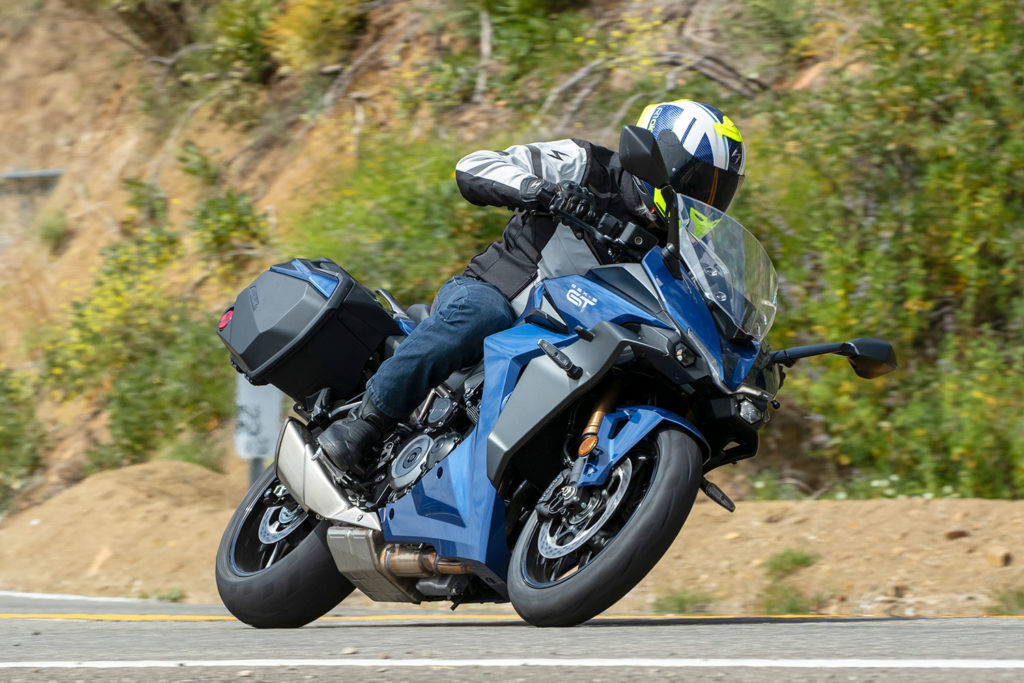
Suzuki is helping sport-tourers make a comeback. With the rise of adventure bikes over the past decade, sport-tourers got shoved aside, relegated to the dark corners of showroom floors. Development cycles stretched out, and model updates became few and far between. That’s a shame. Not everyone wants a motorcycle with a 19-inch front wheel, a 34-inch seat height, and a jungle gym’s worth of crash bars.
Check out Rider‘s 2022 Motorcycle Buyers Guide
As the name implies, sport-tourers combine go-fast performance and touring prowess into a single package. What’s not to love about a superbike engine tuned for the street, a chassis built for both speed and comfort, and ergonomics that won’t make you cry uncle after an hour in the saddle? With their 17-inch wheels shod with grippy radials, sport-tourers love to lean, and modern electronic rider aids help keep things in check.
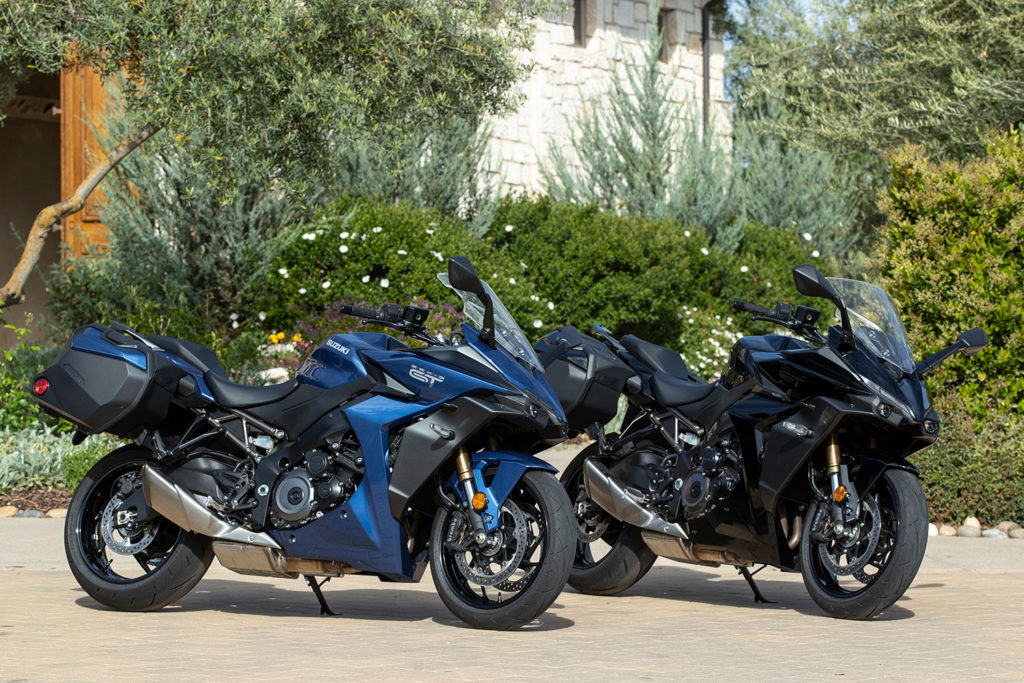
Enter the new-for-2022 Suzuki GSX-S1000GT ($13,149) and GSX-S1000GT+ ($13,799), the latter distinguished by its color-matched side cases. Color options are the Metallic Reflective Blue of our test bike or Glass Sparkle Black. The GT is built on the same platform as the GSX-S1000 naked sportbike we tested recently. But unlike the GSX-S1000F that was in Suzuki’s lineup until 2020, which was little more than a GSX-S1000 with a fairing bolted on, the GT is a true grand tourer.
Look Good, Feel Good
The GT’s bodywork is distinctive and angular, with a wedge-shaped front fairing that juts sharply forward and houses a V-shaped LED position light and a pair of mono-focus LED headlights (for low beam, only the right lamp is illuminated). Attached to the top of the fairing are mirrors perched on the ends of long stalks and a nonadjustable windscreen. Lower fairing panels keep the radiator and much of the engine hidden, and they are vented to pull hot air out and away from the cockpit.

GEAR UP:
Helmet: Scorpion EXO-R1 Air
Jacket: Scorpion EXO Optima
Gloves: Scorpion EXO Havoc
Pants: Scorpion EXO Covert Pro Jeans
Boots: SIDI Gavia Gore-Tex
Two-up comfort was an important consideration in the GT’s development. All the rider and passenger touchpoints – the handlebar, footpegs, and rear grab handles – are rubber-damped to minimize vibration. Compared to the GSX-S1000F, the handlebar is 0.9 inch wider and 0.6 inch closer to the rider, allowing for more steering leverage and a nearly upright seating position. The wide, slightly dished rider’s seat sits 31.9 inches off the deck and is comfortable enough for long days in the saddle. A sporty amount of cornering clearance necessitated high placement of the footpegs, sacrificing some legroom, and they are positioned just below the rider’s hips.
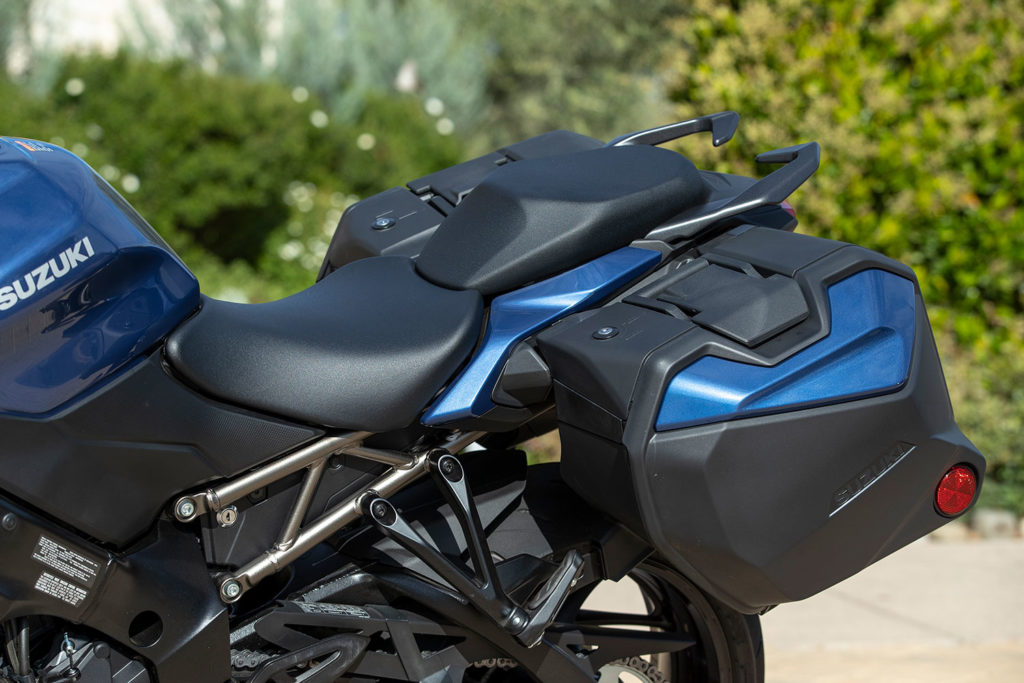
Seat height for the passenger is 34.2 inches, and the 2.3-inch boost in height provides a better view over the rider’s shoulders. Large grab handles allow the passenger to hold on securely to the bike rather than just a strap on the seat or the rider’s hips. Both the front and rear seats have thick, supportive foam and are covered in a slightly grippy weather-resistant material.
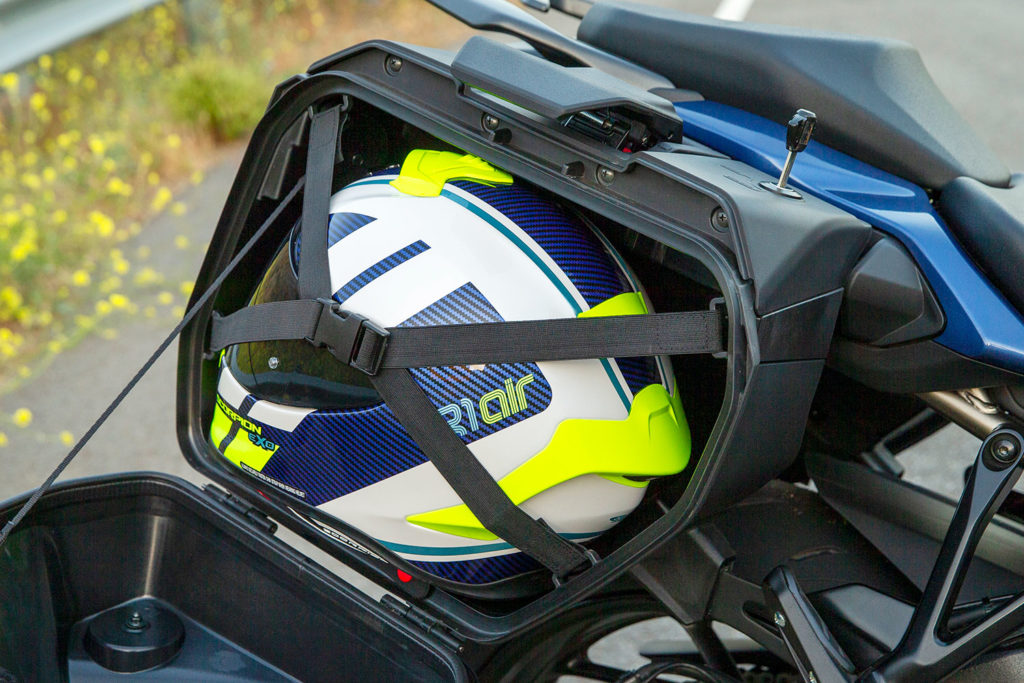
To accommodate the added weight of a passenger and luggage, the GT has a trellis-style subframe that provides both strength and visual flair. The GSX-S1000GT+ comes standard with side cases that hold 25.7 liters (and up to 11 lbs) on each side, and they’re large enough to fit most full-face helmets. The saddlebags are easy to open, close, lock, remove, and reinstall, and they are keyed to the ignition. The only downside is that they cannot be left unlocked for quick access.
Paying the $650 premium for the GT+ is money well-spent. High-quality, lockable, removable, weatherproof saddlebags are undeniably convenient and practical. And buying the cases and necessary hardware as standalone accessories will set you back more than $1,000.
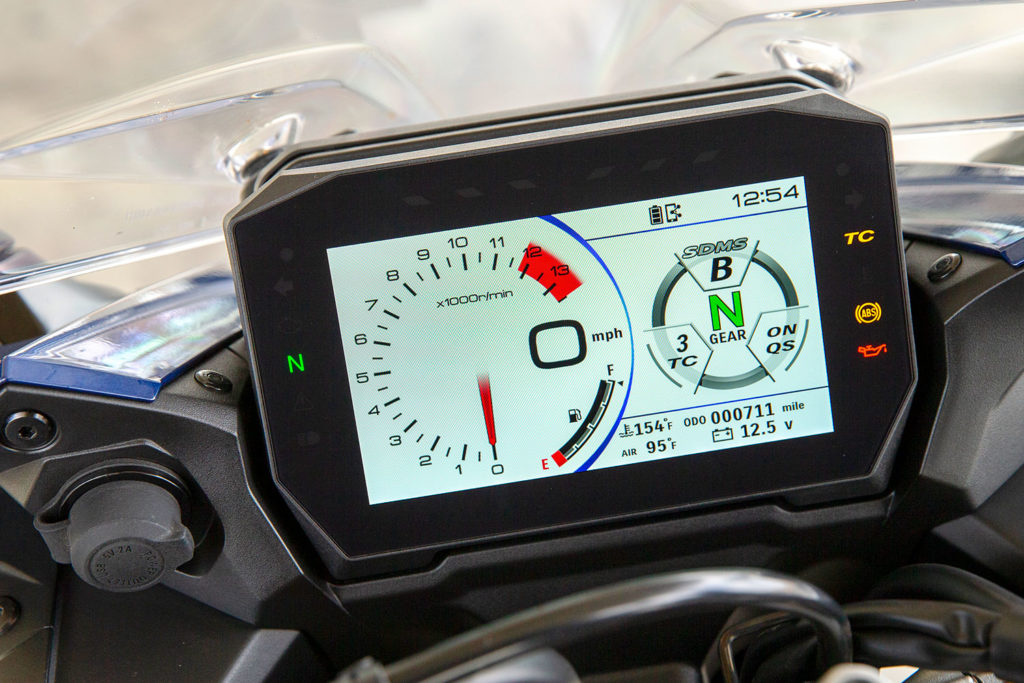
To further enhance the GT’s touring ability, Suzuki gave the bike a 6.5-inch full-color TFT display, all-new switchgear, and Bluetooth connectivity. The TFT has a large analog-style tachometer, a digital speedometer, and a fuel gauge on the left side, as well as an array of bike and trip info on the right. It also has a sensor that automatically switches the background from white in bright light to black in low light.
Buttons on the left switchgear allow the rider to adjust settings and navigate menus. Installing the Suzuki mySPIN smartphone app and pairing via Bluetooth provides access to contacts, phone, maps, music, and calendar functions, which are displayed on the TFT screen. You’ll need a Bluetooth helmet headset to make/receive calls, listen to music, or hear turn-by-turn directions. A USB port on the dash provides on-the-go charging for devices.
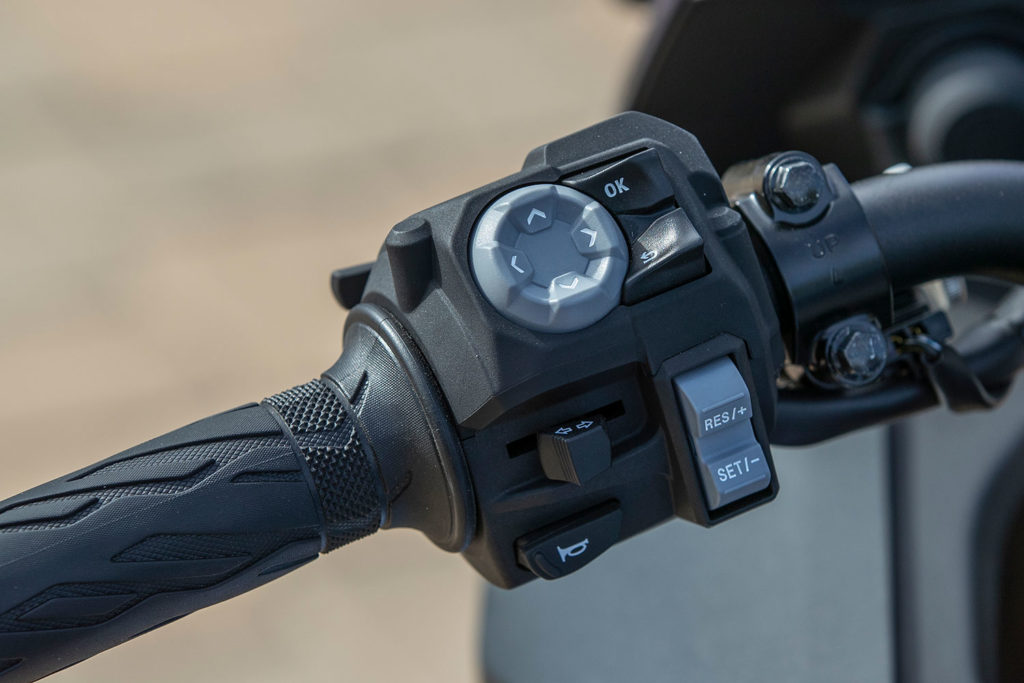
In Thrust We Trust
Like the GSX-S1000, the GT is powered by a 999cc in-line Four adapted from the GSX-R1000 K5 (2005-2008). It’s been retuned to make the engine more suitable for the street, but there’s still plenty of heat in the kitchen. On Jett Tuning’s rear-wheel dyno, the GSX-S1000 churned out 136 hp at 10,200 rpm and 73 lb-ft of torque at 9,300 rpm. Updates to the engine include new camshaft profiles, new valve springs, new throttle bodies, a revised airbox, and a Euro 5-compliant 4-2-1 exhaust. Together, they result in an extra 2 hp at the peak and smoother horsepower and torque curves.
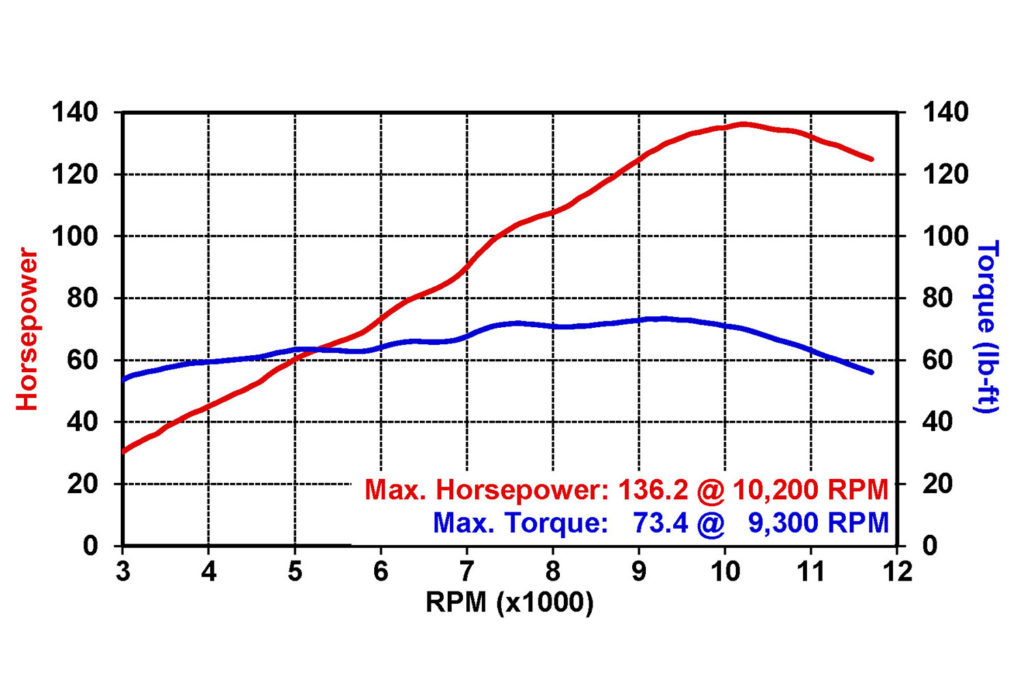
The GSX-S engine is a gem with no rough edges. From cracking open the throttle above idle to twisting the grip to the stop, power comes on cleanly and predictably. Slaloming back and forth on a series of curves with grace and confidence requires accurate additions and subtractions of fuel and air, and the Suzuki mixes them perfectly. Using a throttle-by-wire system, turning the right grip directly activates the throttle position sensor, which sends instantaneous signals to a servo motor that precisely moves the throttle plates. Throttle response is further enhanced by a long, tapered intake tract that is narrower at the bottom where the 10-hole injectors are located.
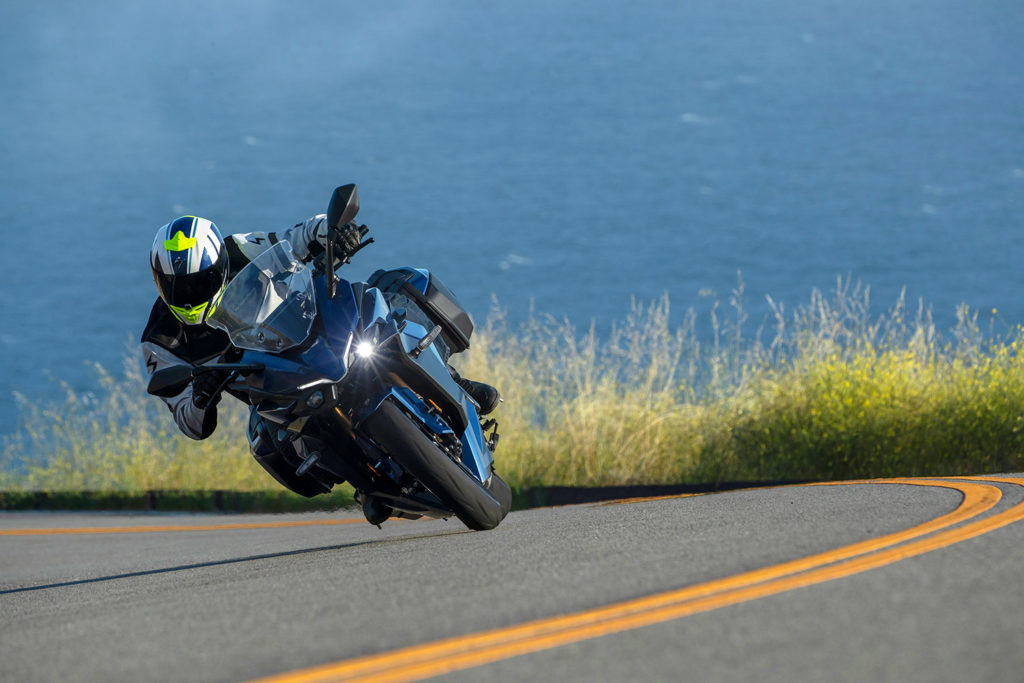
The GT’s throttle-by-wire also enables the Suzuki Intelligent Ride System, which includes three ride modes (Active, Basic, and Comfort) that adjust throttle response and power delivery, 5-level traction control, cruise control, and Suzuki’s Easy Start, Low RPM Assist, and Bi-Directional Quick Shift systems. ABS is also part of the electronics package, but with no IMU, neither it nor the TC are lean-angle adaptive. The 6-speed transmission has a cable-actuated slip/assist clutch. Gear changes using the quickshifter are fast and smooth, and clutch action is light with predictable engagement. Both the clutch and brake levers are adjustable for reach.
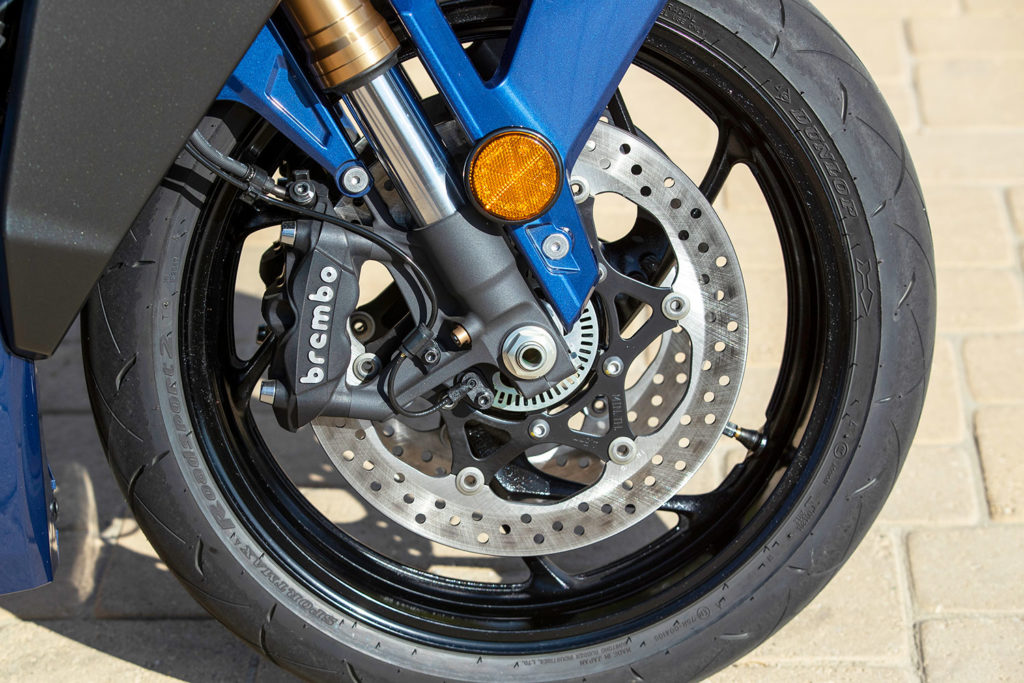
Being derived from a Superbike championship-winning sportbike like the GSX-R1000, the GSX-S1000GT has a massive twin-spar cast-aluminum frame that surrounds the engine and attaches to a cast-aluminum swingarm. KYB suspension – a fully adjustable 43mm inverted fork and a link-type rear shock that’s adjustable for preload and rebound – is taut yet comfortable.
Brembo 4-piston radial-mount monoblock front calipers are mated to fully floating 310mm rotors, and they offer strong power and precise feedback. A Nissin 1-piston rear caliper squeezes a 240mm disc. The GT rolls on six-spoke, 17-inch cast-aluminum wheels shod with Dunlop Roadsmart 2 sport-touring radials that deliver reliable grip and neutral cornering behavior.
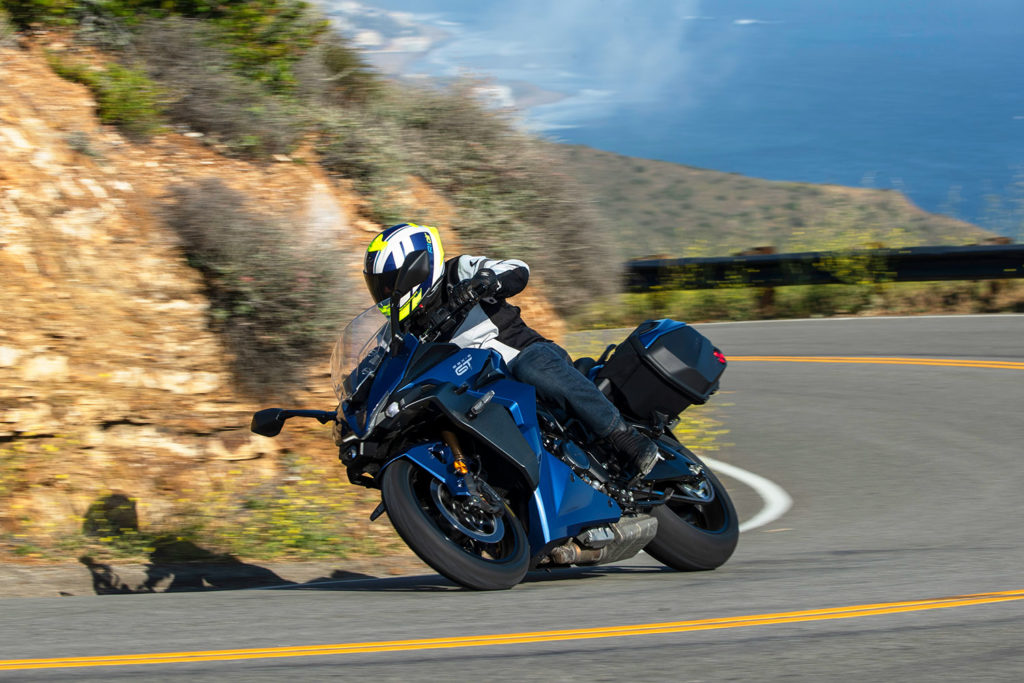
On the Road Again
Suzuki hosted a two-day press launch for the GSX-S1000GT+, with a test route that started and ended at its U.S. headquarters in Brea, California. Back-to-back 300-mile days gave us a chance to thoroughly evaluate the GT in a wide range of conditions, including traffic-choked freeways, wide-open highways, and tight, technical backroads. We followed that up with more miles on a test bike over several weeks on home turf.
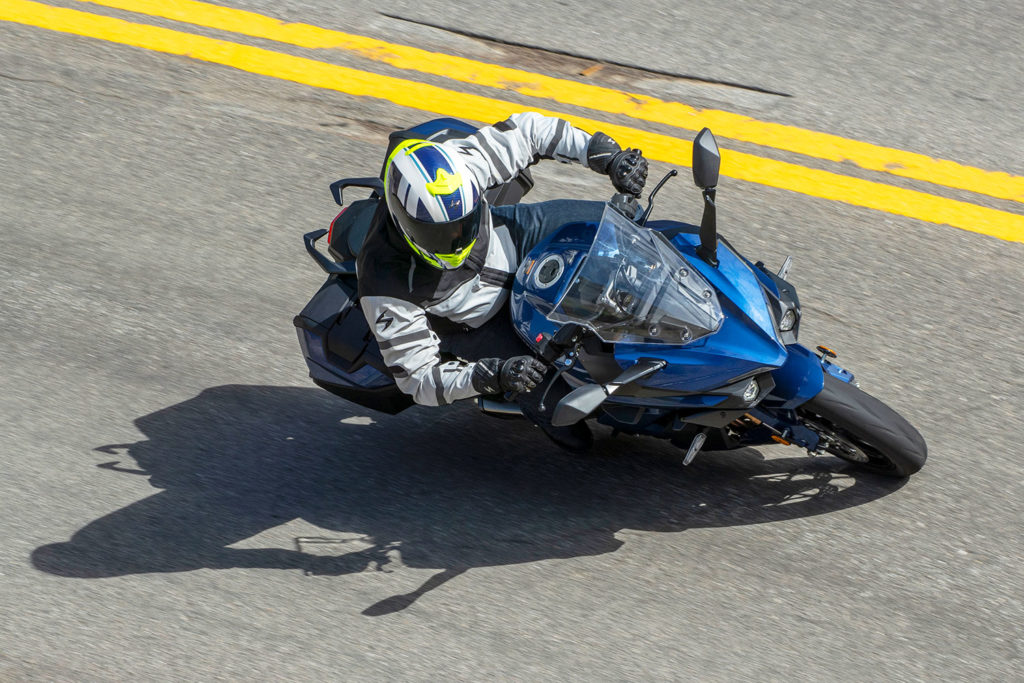
The qualities that impressed us about the GSX-S1000 – impeccable smoothness, predictable handling, unflappable stability, and linear power delivery – carry over to its GT sibling. Likewise, its braking and suspension components and electronic rider aids were selected to deliver sporting performance without inflating the retail price.

Where the GT really stands out is its rider and passenger comfort, cruise control, instrumentation and connectivity, and, on the GT+, stylish and useful saddlebags. Weighing in at 521 lbs with its 5-gal. tank full, the GT+ is much lighter than open-class sport-tourers like the BMW R 1250 RT (615 lbs), Yamaha FJR1300ES (644 lbs), and Kawasaki Concours 14 (691 lbs). It weighs more than the Yamaha Tracer 9 GT (503 lbs) but makes significantly more rear-wheel horsepower (136 vs. 108). With its cornering ABS and TC and semi-active suspension, the Tracer 9 GT also costs $1,200 more than the GSX-S1000GT+ ($14,999 vs. $13,799).
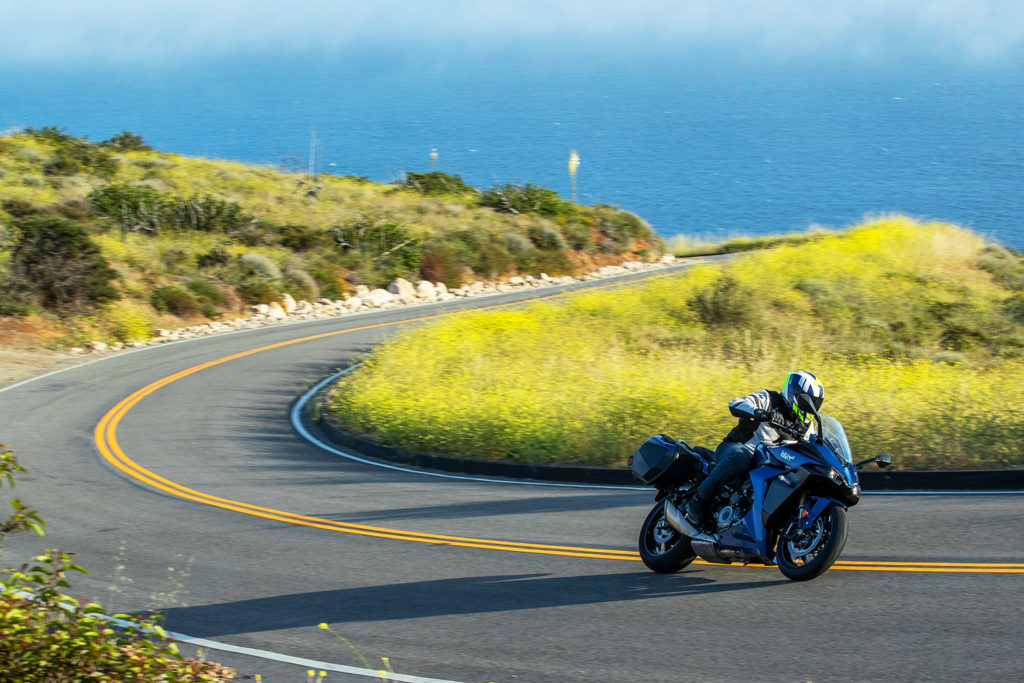
If the GT has one notable shortcoming, it’s the nonadjustable windscreen. Though Suzuki says it and the bodywork were developed in a wind tunnel, airflow over the windscreen hit me square in the chest and created a lot of turbulence around my helmet. Of course, the size of the rider plays a role in aerodynamics (I’m 6 feet tall), but the lack of height adjustability means you get what you get. Suzuki makes an accessory touring windscreen ($169.95) that is 2.75 inches taller and has a more vertical pitch near the top, but one was not available during our test.
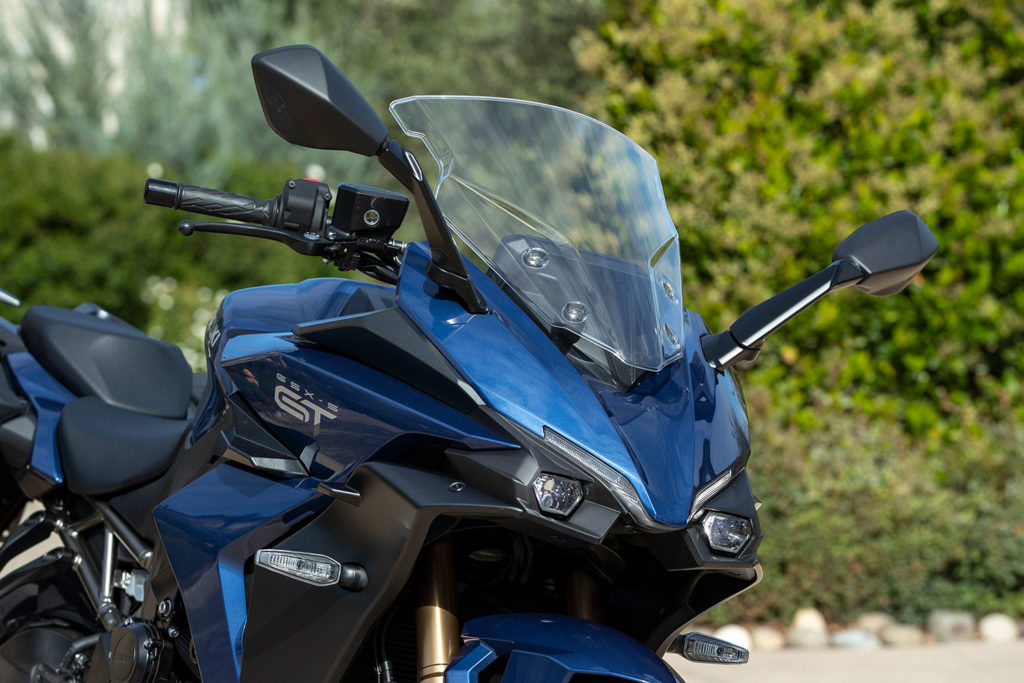
Other available accessories include heated grips, a two-tone rider’s seat with a suede-like cover embossed with the GSX-S GT logo, axle sliders, ring-lock tankbags (small and large), tank pads and protectors, and wheel rim decals.
We’re glad to see Suzuki helping bring the sport-touring class to its former glory. The GSX-S1000GT+ strikes an excellent balance between performance, technology, weight, comfort, and price. Life is good when the scenery is a blur.

2022 Suzuki GSX-S1000GT+ Specs
Base Price: $13,149 (GT)
Price as Tested: $13,799 (GT+ w/ 25.7L side cases)
Warranty: 1 yr., unltd. miles
Website: suzukicycles.com
ENGINE
Type: Liquid-cooled, transverse in-line Four, DOHC w/ 4 valves per cyl.
Displacement: 999cc
Bore x Stroke: 73.4 x 59.0mm
Compression Ratio: 12.2:1
Valve Insp. Interval: 15,000 miles
Fuel Delivery: EFI w/ throttle-by-wire, 40mm throttle bodies x 4
Lubrication System: Wet sump, 3.6 qt. cap.
Transmission: 6-speed, cable-actuated slip/assist wet clutch
Final Drive: O-ring chain
CHASSIS
Frame: Twin-spar cast aluminum frame & swingarm
Wheelbase: 57.5 in.
Rake/Trail: 25 degrees/3.9 in.
Seat Height: 31.9 in.
Suspension, Front: 43mm inverted fork, fully adj., 4.7 in. travel
Rear: Single linkage shock, adj. spring preload & rebound, 5.1 in. travel
Brakes, Front: Dual 310mm floating discs w/ 4-piston radial monoblock calipers & ABS
Rear: Single 240mm disc w/ 1-piston caliper & ABS
Wheels, Front: Cast, 3.5 x 17 in.
Rear: Cast, 6.0 x 17 in.
Tires, Front: 120/70-ZR17
Rear: 190/50-ZR17
Wet Weight: 521 lbs (as tested)
Load Capacity: 405 lbs (as tested)
GVWR: 926 lbs
PERFORMANCE
Horsepower: 136 hp @ 10,200 rpm (rear-wheel dyno)
Torque: 73 lb-ft @ 9,300 rpm (rear-wheel dyno)
Fuel Capacity: 5.0 gals.
Fuel Consumption: 35.5 mpg
Estimated Range: 178 miles






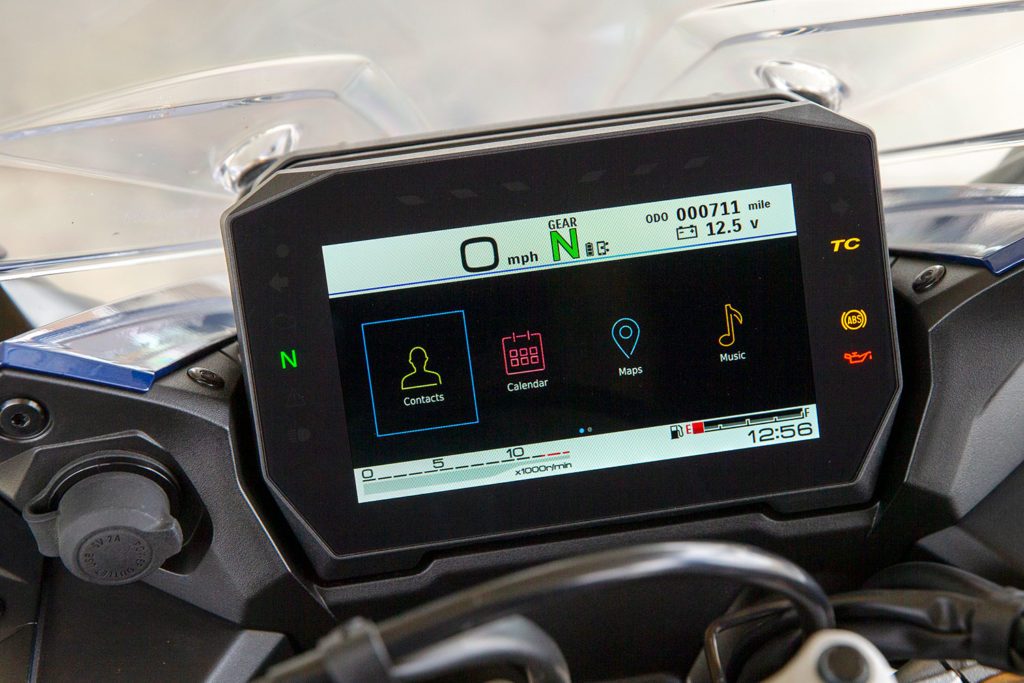
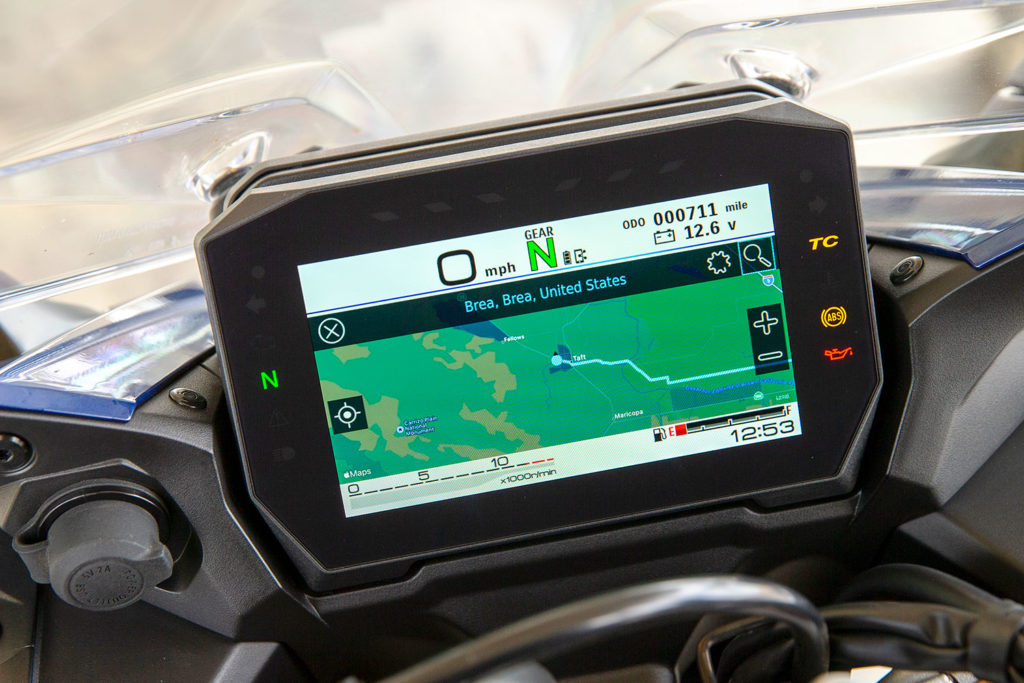

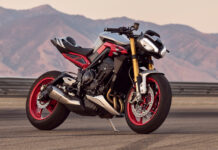
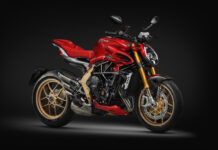


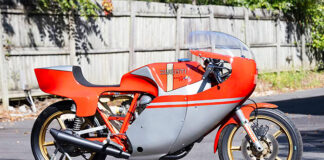

Anybody know where you can actually buy one of these? The dealers I’ve contacted in NM and CO say it’s not available and probably won’t be until the 2023 MY.
I picked one up in the Seattle area at the beginning of June after putting a deposit down around the beginning of March. I used Cycle Trader to search a radius around my zip code to find a dealer close enough.
Looks like only two dealers listing it in the west on Cycle Trader right now (PCP Motorsports – Sacramento, CA) and another dealer near Seattle (Nash Motorsports).
Rob ,can you tell me if this bike has a metal gas tank or a plastic one with a bodywork cover over it as I would have to make enlarging the tank by at least a gallon and a half to two gallons my first mod to it.
metal, it takes a magnetic tank bag fine, just did a road test on it.
great machine.
contact Suzuki they will send a demo to your nearest dealer for you to test drive and if you like it you can order one that’s what I did.
Seat too low and pegs too high. Cramped . Thin seat and low bars . Bad windshield.
Everything says UNCOMFORTABLE. Most of the reasons why sport touring bikes have lost their appeal. Give me a V-Strom or Africa Twin any day.
Wait what? A V Strom or Africa twin? What are you like 6’8″?
I have a triumph tiger as well as this Suzuki and the Suzuki is just as comfortable even for an oldie like me.
This bike feels like was made for anyone under anyone under 6 ft uh? They need to design this bike so it’s more comfortable for the rider no matter what. They attempted and failed to met that in my opinion. Great handling bike though
So, sounds like it’s not made for the taller rider, good, I’m 5’8″—could be just right for me. It’s got a shorter seat than my GSX-S750 (32.3″), which is a little higher than I’d prefer. This bike is a sport-tourer but caters towards the sportier side more than full-blown tourer, perfect for someone like me that’s thinking of making the transition to something with wind protection and more power. Best thing about it is the GSX-R1000-derived engine, a legendary motor with more than enough power. It’s hand down better than the Kawasaki Ninja 1000SX, read the reviews vs it’s primary competitor. the Ninja 1000SX has a higher seat height at 32.3″ and less horsepower at 140 vs Suzuki’s 150. Also, the Suzuki GT version only weighs 498 lbs. vs Kaw’s 514 lbs. Another better thing that the Suzuki has over the Kawasaki is a better-looking muffler, much smaller. I’ll stick with the Suzuki brand, best bang for the buck manufacturer for many models. Japanese reliability unmatched vs others.
Too bad it is chain drive.
Could be The One! But riding the GT outside of a two-day thrashing, it will be important to find out what real-world gas mileage is. The as-tested 35.5 mpg is dismal at best, especially for a bike with a GT moniker (and with gas at about $7/gal!). When you do the inevitable head-to-head with the 1000SX, let’s see what can be squeezed out when riding like you ACTUALLY own it. I am also looking forward to seeing how well the touring windshield works, and if the aftermarket will be providing some peg lowering kits (like they’ve been doing with the Hayabusa). This bike is very intriguing!
I have one … I rode 165 miles on it yesterday, averaging a – measured by used fuel volume – 52mpg (UK galls), equivalent to a tank range, brim to dry of 217 miles. I gave it the berries on several occasions, but mostly swift A-road (highway) speeds in the 45-85mph range.
they look very nice but nobody seem to go out at night to see if the headlight is any good,,,they should offer alternative screens for different size people as well although i think you have a choice of one from the factory.
We admit that our testing regimen doesn’t not prioritize fuel economy, especially on sportbike-based machines like this one. If riders want to conserve fuel, they can short shift to high gears, stay relaxed on the throttle, and use cruise control often.
that is pretty much standard for a new bike, bikes tend to get better gas mileage as the miles pile up. but it all depends on the rider.
Interesting article. I could relate on many topics as I am a seasoned Suzukiman myself. I see however that you do not have any actual pictures of the engine itself. That is the best part of Suzukis is they often house a real golden gem of an engine with simplicity and humility. Mission number one with Suzuki is the tightly tuned engine with it designed to rev high to the line with a thirst for more, driven hard put away wet as the American Muscle Car Guy might say. Looking forward to seeing the engine. Thanks.
Takeo Yamaguchi
Sounds like a great bike. I’ll need to get on one for a demo ride
Chain….no center stand……next!!
Exactly. Two items that are absolute musts for me to even consider a sport touring bike today.
Huge bang for the buck. Should also be after-market opportunities for foot peg lowering kits and thicker seats.
I have a K1600GTL that gets 45 mpg and has excellent wind protection but have been interested in the GSXS 1000GT for the lower weight and because I like Suzuki’s. Like KJS says, where to find one? I hope Suzuki gets their dealer and supply issues ironed out this year.
1st 35 mpg is terrible with technology that my 04 FJR1300 gets 40mpg. and 2nd is 141hp. Disadvantages is no 6th gear and maybe newer technology ABS and cruise control. But I carry more luggage and have more comfort with an adjustable height windshield. $13k is robbery. I’m an avid Suzuki fan. Owned a few Suzukis hoping for a sport touring bike like the old Gsx katana 1100. A rebirth I would purchase immediately with today’s tech.
Jamie. I still have my 1993 GSX1100 F, I would love to find someone I can trust to do some work on it.
That’s what this is, though. Today’s tech using a capable and proven platform (minimal bespoke parts). Today’s tech in a 1000cc sport touring bike costs $13k. Don’t really know what you’re complaining about here.
What are you guys smoking? Lowering the pegs on a sportsbike? Raise the saddle in that case… But yeah, they could have had an optional centerstand.
Non adjustable windscreen? Not even manually adjustable? On a touring bike, what were they thinking? Chain drive frees up some power but it’s not as maintenance friendly or reliable as a shaft drive if you’re going long distance. At least heated grips are an option. But it’s hard to get over the high rearward placement of those pegs. It’s nice but not enough to sway me away from my FJR.
I guess it depends on your perspective. Most of gripes I read here seem to be from touring-focused riders rather than sport-focused riders. I find the new Suzuki very appealing. I was considering it’s predecessor, which gets rave reviews from people who have them, but I didn’t like the looks. This new one looks good. I’m primarily a sport rider who wants a bit more comfort and luggage capacity in my old age. Gas mileage? Yea, I can’t argue it’s not important, but it’s not in my top-10 of factors I look at. Non-adjustable wind screen? Never had one. I think Suzuki’s put together a very capable machine for a very reasonable price. Go ahead and ride your 2004 Yamaha 1300. I never considered one of those giant boat like sports tourers, and would prefer an adventure style bike if practicality/gas mileage/seat height/ultimate comfort were my priorities.
Very well stated MRPC. Agree on all counts. Suzuki isn’t surprised to see that FJR1300 owners aren’t flocking to this bike.
Suzuki went more after the sport bike rider and focused less on the touring end with chain drive, high set-back foot pegs, and lack of center stand. Those attributes won’t likely entice current FJR1300 or C14 owners into making a trade for this bike. Maybe they can win some sport bike owners over with the low price and light weight.
I got mine this week. Was searching for months until one showed up in my area that was not already spoken for.
However even though its the GT+, Suzuki shipped it with no bags. They are supposed to arrive in 6 weeks. Love the bike.
Nice article! I think I’ll buy one. I am a bit worried from other reviews that 6th gear is too short and people say searching for 7th…so revving a bit high at freeway speeds? Otherwise I’ll opt for the heated grips and touring windscreen and I’ll be set! I miss my RT1200 but think the light weight, suzuki reliability and performance will go a long way!
Bought this bike in June. Yes, it’s true, that the 6Th gear should be taller. Not sure how or why Suzuki missed this on a bike designed for sport tourer. It’s also strange that few online reviewers ever mentioned it (and I watched many videos). Also, the seat is uncomfortably hard and very hot (again, how did Suzuki missed this on a sport tourer?)
Those are my only gripes though. And now that I’m more in tune with the engine, it doesn’t bother me as much. And Corbin is coming out with an aftermarket seat next week. Everything else about the bike is outstanding for a super sport tourer, and a big step up from my trusty 5th gen VFR800.
Just purchased one a couple weeks ago. The only one available in a 500 mile radius of Houston Texas. Loving the bike so far. Pros – the engine and the slickest transmission I’ve ever rode. It is effortless to shift smoothly…and the quick shifter is top of the class. I’m coming off a naked bike with zero wind protection so I’m fine with the stock windscreen…have a puig visor on order to tweak the wind flow on long highway slogs..otherwise it’s fine, it’s a motorcycle!! The looks are amazing IMO. Only con I have thus far is the seat…that’s a very personal gripe and your mileage may vary; maybe with more riding time it will break in or my ass will conform to it. Love the TFT as well, Sygic is a navigation app which works perfectly on the bright and high res screen. The built in maps app is very basic. Overall I’m stoked with my purchase!
I got one of these bikes back in June and now have ~2000 miles on it. I average about 42 mpg. I am 6’2″ tall and a big guy. I also put on the touring windshield and the optional seat. The optional seat gave me just a little more room for my legs and it is a lot more comfortable. The taller windshield makes the highway miles more enjoyable without taking all of the air away.
I have decades of experience riding all types of bikes and also own multiple types of bikes. This bike is now my main bike and the most enjoyable bike. That is both for riding the highway and mountain canyon carving.
I would and do recommend this bike to the type of people that would like. With the selection of bikes in the market place there is a bike for everyone. This one is perfect for me and what I want to ride. It is a great all around fast and reliable bike that does many things great
This is the motorcycle that I always wanted when I was younger. I’m glad to see they finally made it!
As 50 gets closer and my knees get a little less flexible, the thought of tucking up on the pegs gets to be less desirable. I also don’t want to do chain maintenance any more. A drive shaft seems like a better alternative. The problem is, there is always a weight penalty with a shaft drive. I wish someone would figure out how to keep the weight down around the 500-550 range with a shaft drive. The thing is, I’ve owned a heavier sport tourer and never could connect with it because of the weight. Every motorcycle I’ve owned that is on the lighter side has always been more dynamic and enjoyable.
I’m not a long touring guy, but I typically like to do extended single days. I appreciate some luggage capacity, but don’t need a Goldwing. This looks ideal in that regard.
It looks like they got so much right with this, but they are missing one ingredient that could make this bike even more successful: Factory customization options.
My friend is on the short side, closer to 5′, while I’m well over 6′. I find we seem to like the same bikes, but the requirements and options vary because of our size differences. He is put into a position where he has limited options due to his inseam, and so am I. Why do manufacturers not offer a selection of footpegs / shifters, seats, bars, and windscreens made to suit different riders? Why not offer two chassis options- low and high?
If this had been available 20 years ago, I would have bought it instead of my FJR, largely because of the 120lb weight difference. Shaft drive weight ruins fun. Now I’m too old for a bike designed for 5’6″ riders.
That sums it up buddy.
The new Suzuki GSX-S1000GT and GT+ offer a promising blend of sporty performance and touring comfort, making them an attractive option for riders looking for versatility in their motorcycles.
I own 2023 Ninja 1000SX and what’s interesting here is most the complaints on the Suzuki (which are really minor) have been addressed on the Kwak. Motorcycles are such a deep personal choice good luck finding a perfect one. I studied the Ninja for several years….I f the Suzuki doesn’t do it for ya maybe the Kawasaki will
I bought a 2016 GSX-S F (fairing) brand new. Wife didn’t like the puny passenger perch, so I got a used ’03 ST1300 a couple years later for 2-up duty. For the price of both, I coulda had the GT+
…anyone wanna trade my two lo-miler bikes for one of these in blue? [insert laugh emoji]